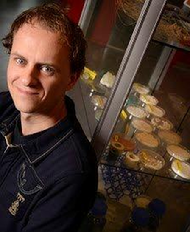Design of efficient catalysts for gasification of biomass-derived waste streams in hot compressed water
Promotion date: February 8
Promotor: Prof. dr. K. Seshan
Promotor: Prof. dr. ir. Léon Lefferts
| Biomass is believed to be a promising renewable energy source for the future. Conversion of biomass waste to liquid fuels or hydrogen is projected to provide, partly, the required energy demand. Intensification of biomass conversion processes will result in an increase in biomass derived aqueous waste streams (e.g. the aqueous phase of flash pyrolysis oil). Gasification of these wastes to produce high energy value gases (e.g. hydrogen) is an interesting way of diminishing waste by making valuable products. Aqueous phase reforming (APR) is a recently developed process. During APR, water is kept in the liquid phase by applying elevated pressures. The exact reaction conditions of APR have a huge influence on the properties of water, which in turn affect the catalytic reforming reaction. Especially, an enormous change in properties occurs when the water is conditioned beyond the supercritical point (> 374 °C and 221 bars). Earlier work in this field shows the need for stable and active reforming catalysts. The experimental setup used is able to perform experiments up to 450 °C and 250 bar in a continuous mode by using a fixed bed reactor. Ir, Pt and Ni catalysts were selected as possible catalysts. These were tested for catalytic reforming of ethylene glycol (EG) in supercritical water. The deactivation mechanism of Pt/Al2O3 during APR of EG and the role of Ni in enhancing catalyst lifetime and H2 selectivity was discussed. Carbon nanotubes (CNT) are widely recognized for their excellent physical and chemical stability. The performance of Pt decorated CNT was studied. The remarkable stability of CNT offers great potential for catalysis in supercritical water. However, the activity of Pt/CNT was too low to be relevant for commercial applicability. Further optimization of the catalyst resulted in the development of a Ru/CNT catalyst. It is projected that the APR technology developed in this thesis is applicable for reforming of other aqueous bio/organic aqueous waste streams that are produced in large quantities in the paper and food production industry. |
Was your thesis research application driven?
For the Catalytic Processes and Materials (CPM) group the topic of aqueous phase reforming is rather new. The reason for starting the search for catalysts, lies in the relevance of producing renewable energy carriers while simultaneously diminishing bio/organic waste from a variety of industries. We believe the commercial potential of aqueous phase reforming is of major importance as it can be applied, in principle, to every high-concentrated bio-organic waste stream. The developed Ru/CNT catalyst showed commercial relevant gasification activities.
However, a few issues remain to be solved. First of all the catalysts involved should be stable for several days, weeks or even years in a row under severe, supercritical conditions in an acidic environment. In the current study it was only demonstrated for eight hours. Also the selectivity towards hydrogen has to be enhanced significantly.
Especially the Ruthenium on carbon nanotubes catalyst proved to be promising in my thesis project. This was never done before. It is the first catalyst developed that showed stable reforming results for many hours. Ruthenium, however, is very costly. Also some new engineering problems arose during my project. For instance, we found that certain compounds transform to coke, which can clog up the tubes of the setup. This severely influences the reaction efficiency.
The experiments on the nanotubes, though, were very exciting, leading to nice results and a good insight in the way these processes advance. The results were beyond expectation. A fellow-PhD will take up this work, starting from a rather fundamental level, to gain more understanding of the reactions mechanisms that play a role on the catalyst surface. Stability and reforming activity will still be the key factors here.
In what way did you develop personally, as a scientist and researcher?
I am much more critical now with regard to the experimental results obtained. Feasibility and relevance for society I value greatly, next to scientific relevance. I am an engaged scientist, aiming to contribute to new energy sources for future use.
The nano tubes fitted into this strive, trying to find new promising techniques. Ruthenium is not very likely to lead to a widespread use, as this material is very scarce and costly.
What are your future plans?
Right now I am applying in industry. I hope to find an application oriented research job, working on near-to-market products. However, I would love to stay connected to scientific research too, looking for collaboration projects and partners at universities and institutes.
The creativity of the scientists here at Mesa+ is overwhelming. On the other hand, academic researchers sometimes are a bit carried away by their own topic of research. I hope to find best of both worlds in my future job.
What, in your opinion, is important for Mesa+ to stay successful in future?
The collaboration with industry can lead to very inspiring research projects, I am convinced. Here at Mesa+ the combination of expertise and research equipment is unique. Breakthrough results might come out of that in the near future.

